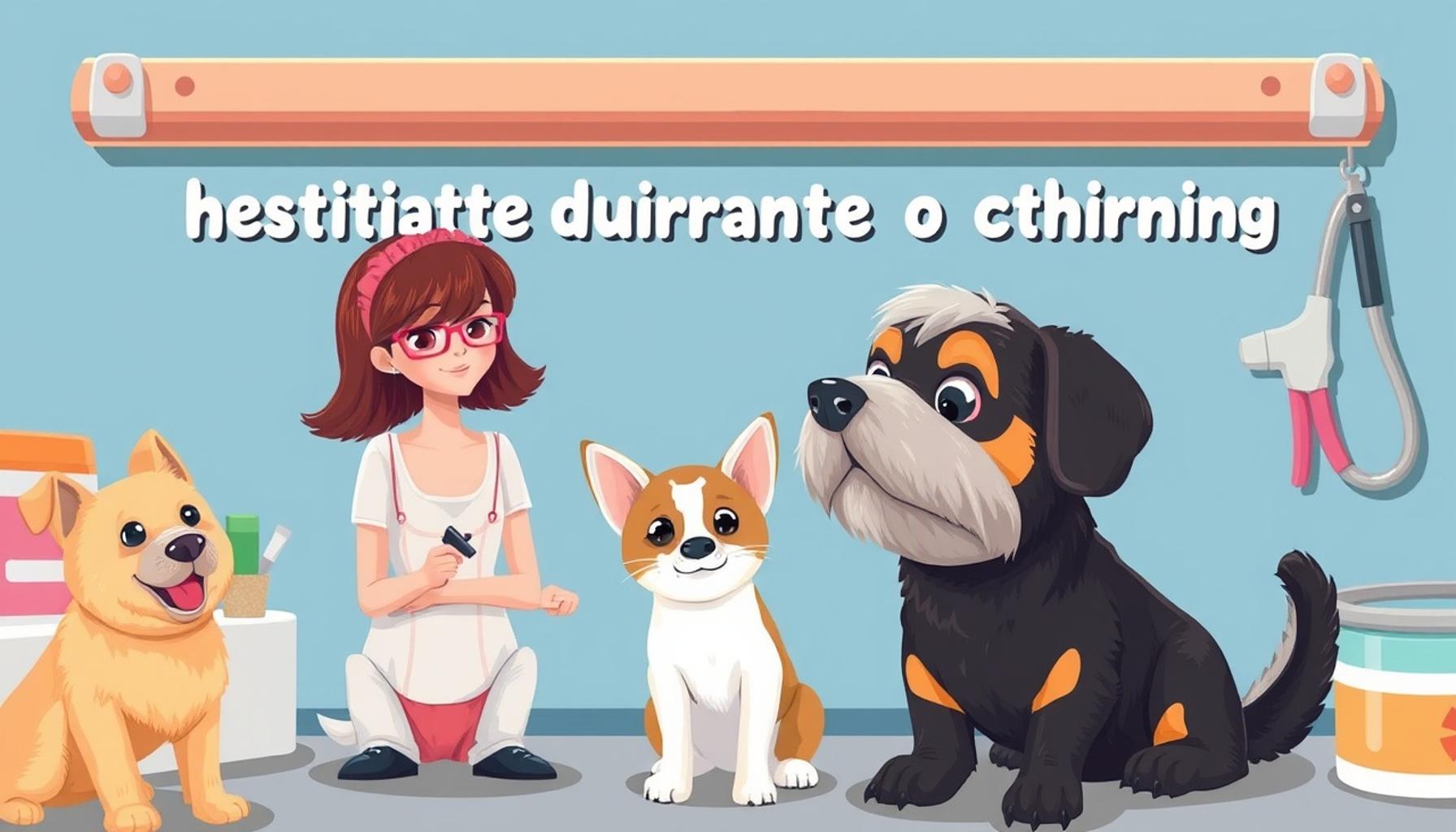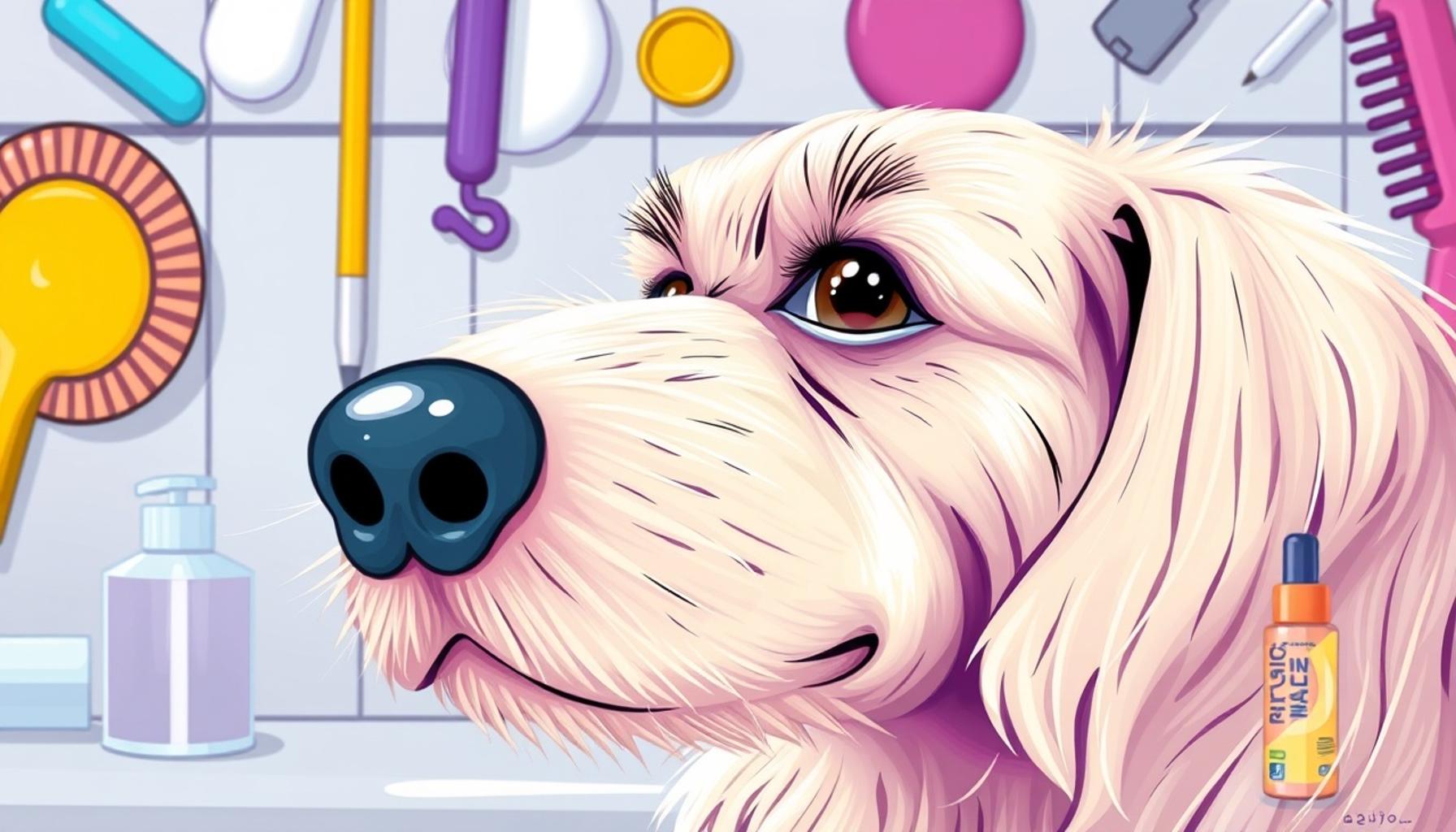How to Deal with Hesitant Pets During Grooming: Strategies and Tips

Understanding Hesitance in Pets
Pets can often exhibit a reluctance towards grooming, which can significantly affect not just their appearance but their overall health as well. This hesitance may arise from a variety of sources, including previous negative experiences with grooming, unusual or intimidating grooming tools, unfamiliar scents, or general anxiety regarding the grooming routine. By recognizing the signs of discomfort and implementing effective strategies, pet owners can create a more positive grooming experience for their furry companions.
Common Signs of Hesitance
- Refusal to approach grooming tools: A pet that avoids brushes or clippers may be expressing discomfort or fear associated with these objects. For instance, a dog that sharply backs away from a hair dryer could have had a past experience where the noise startled them.
- Body language: Pets communicate extensively through body language. Signs such as cowering, whining, or tucking their tail between their legs are indicative of fear and anxiety during the grooming process. For example, a cat may freeze or hiss when confronted with clippers, signaling their distress.
- Resistance: Struggling or trying to escape during grooming rituals is a clear sign that your pet is uncomfortable. If your dog squirms away during brushing or attempts to jump off the table, it’s crucial to take these cues seriously.
Grooming is an indispensable aspect of pet care, as it contributes to both health and hygiene. A well-groomed pet is less likely to have skin issues, matting, or pests. However, if the grooming process is a source of anxiety for your pet, it can turn into a stressful ordeal for both parties involved. By learning effective methods to manage hesitant pets, owners can not only streamline the grooming experience but also strengthen the bond with their furry friends.
Why It Matters
In the Nigerian context, understanding how cultural practices impact pet treatment is vital. Many pet owners may come from backgrounds where pets are primarily seen as working animals or companions with less emphasis on grooming. Therefore, incorporating gentle handling and positive reinforcement becomes essential to create a soothing atmosphere during grooming sessions. Training your pet with patience and utilizing rewards—such as treats or praise when they display calm behavior—can greatly improve their response over time.
Next, we will delve into effective strategies and tips tailored for Nigerian pet owners, from selecting appropriate grooming tools to establishing a comforting routine. Understanding these practices will not only enhance your grooming experience but also ensure that both you and your pet feel secure and at ease throughout the process.
CHECK OUT: Click here to explore more
Creating a Comfortable Grooming Environment
Establishing a positive and calming grooming environment is essential to help your pet overcome their hesitance. It starts with selecting the right grooming tools. Many pets may feel anxious around unfamiliar objects, so introducing them slowly can make a significant difference. Choose brushes that are designed specifically for your pet’s coat type and ensure that clippers are quiet and gentle. Tools with softer bristles or ergonomic handles can also help your pet feel more secure during the grooming process.
Another crucial element is grooming location. A designated, familiar spot in your home—whether it’s a specific corner of the living room or a designated grooming table—can help your pet associate that space with positive experiences. Here are some tips to create a welcoming grooming area:
- Comfortable Surface: Use a non-slip mat or blanket to make the surface comfortable and secure for your pet. This will help them feel stable and less likely to squirm.
- Environment Control: Keep the space quiet with minimal distractions to prevent triggering any anxiety. Soft music can also serve as a calming backdrop during the grooming session.
- Familiar Scents: Introducing familiar scents through toys or blankets can create a more home-like atmosphere, easing your pet’s nerves.
Establishing a Routine
Consistency is key in building your pet’s comfort level. Establishing a regular grooming schedule not only normalizes the process but also helps your pet predict what to expect. Frequent short sessions can be more beneficial than infrequent long ones. This approach encourages gradual exposure to grooming, reinforcing positive behavior over time.
Consider incorporating grooming into your daily routine, such as brushing your pet while watching television or after a walk. This integration can help alter their perception of grooming from a chore to a shared bonding activity.
In addition to frequency, timing is also crucial. Identify moments when your pet is naturally calm or relaxed, such as after a meal or a walk. By aligning grooming with their comfortable times, you’ll encourage cooperation and reduce hesitation.
Positive Reinforcement Techniques
Utilizing positive reinforcement techniques is perhaps one of the most effective strategies for overcoming grooming hesitance. Rewards such as treats, praise, or playtime help reinforce good behavior, making your pet more likely to cooperate in future grooming sessions. When your pet remains calm during grooming, immediately reward them with a treat or verbal praise. This positive association will encourage them to respond better over time.
Remember, patience is essential. There may be setbacks along the way as each pet is unique in their temperament and experiences. By creating a comfortable environment, establishing a routine, and employing positive reinforcement, you can significantly improve your pet’s confidence and reduce their hesitance during grooming. Careful attention to these strategies will foster not only a positive grooming experience but also a stronger bond between you and your pet.
When addressing the challenges of grooming hesitant pets, understanding their behavior is crucial. Many pets, especially dogs and cats, may associate grooming with negative experiences or are simply unfamiliar with the process. To navigate this issue effectively, it’s important to employ a variety of strategies designed to make grooming a more positive and less stressful experience for both the pet and the owner.One effective approach is to create a calm and inviting grooming environment. Ensure that the area is quiet, free from distractions, and filled with comforting scents. This can involve using calming pheromone sprays or diffusers designed specifically for pets. Consider playing soft music to help soothe anxiety during grooming sessions. Another vital strategy is to introduce grooming tools gradually. Allow your pet to sniff and investigate brushes, clippers, or combs before use. Begin with short grooming intervals and reward your pet with treats and praise for even the smallest cooperation, reinforcing positive behavior. This method can create a positive association with the grooming process, encouraging your pet to feel more at ease.For pets that display pronounced anxiety, consider using a practice technique known as “desensitization.” This involves slowly acclimating your pet to the grooming process over several sessions, starting with simply handling their paws or gently brushing for a few seconds. Gradually increase the duration and complexity of the grooming sessions, ensuring to remain patient and attentive to their comfort levels.Finally, consider professional help if your pet’s hesitation persists. Groomers who specialize in anxious animals can provide a wealth of strategies to help your furry friend gain confidence in the grooming process. By understanding your pet’s fears and employing these strategies, you can transform grooming from a tense chore into a bonding experience. With these techniques in mind, owners can help their pets feel safer and more comfortable during grooming, leading to a healthier and happier grooming routine.
| Strategies | Benefits |
|---|---|
| Create a calming environment | Reduces anxiety, promotes relaxation |
| Gradual introduction of tools | Builds trust, encourages cooperation |
| Desensitization techniques | Increases comfort, diminishes fear |
| Seek professional help | Access expert advice, tailored strategies |
ADDITIONAL INSIGHTS: Expand your understanding here
Utilizing Distractive Techniques
In addition to creating a calming environment and establishing a routine, employing distractive techniques can help ease your pet’s hesitance during grooming sessions. Pets, especially those that are anxious, often require a diversion to shift their focus away from what they perceive as a stressful event. Here are several strategies to effectively implement distractive techniques:
- Treat Puzzle Toys: Providing your pet with a treat-dispensing puzzle toy can captivate their attention, making them less aware of the grooming process. These toys encourage them to focus on working for their snacks, engaging their minds while you groom them.
- Interactive Play: Consider integrating short interactive play sessions with toys like feather wands or tug ropes before and after grooming. Not only does it help alleviate anxiety, but it also creates a positive association with the grooming process.
- Calming Products: Various calming products, such as anxiety wraps, pheromone diffusers, or calming sprays, can help make your pet feel more at ease. Consult with a veterinarian about suitable options that might work well for your pet specifically.
Gradual Desensitization Techniques
For pets that experience considerable fear, implementing gradual desensitization techniques can be highly effective. This method involves slowly introducing your pet to various aspects of the grooming experience to help diminish their anxiety gradually. Here’s how to do it:
- Start with the Tools: Allow your pet to explore grooming tools at their own pace. Place the brush or clippers nearby while rewarding calm behavior with treats. This non-threatening introduction lets them become familiar with tools without the pressure of immediate grooming.
- Incremental Touch: Instead of jumping straight into grooming, begin with gentle touches on their body similar to the grooming action. Praise and reward them after each touch. Slowly increase the intensity by mimicking brushing motions without using the actual brush initially.
- Short of Sessions: Start with only a few minutes of grooming at a time. As your pet becomes more comfortable, gradually increase the duration, ensuring that each session concludes on a high note with a reward.
Seeking Professional Help
Sometimes, despite all efforts, pets may still exhibit extreme hesitance or anxiety during grooming. In such cases, it may be beneficial to seek professional help. Professional groomers often have experience with hesitant animals and can provide insight into best practices. Many groomers and trainers offer gentle techniques aimed at fearful pets.
One approach is to observe how professionals handle pets. This can provide invaluable insight into effective techniques and allow you to replicate them in your own grooming sessions. Additionally, some veterinarians offer behavioral training courses or collaborate with professionals who focus on addressing anxiety in pets.
As you navigate these strategies, remember that each pet is unique. Patience is vital—progress may be gradual, and building trust takes time. By utilizing distractive techniques, gradual desensitization, and seeking professional guidance when necessary, you can transform grooming from a stressful event into a more enjoyable experience for both you and your pet. The journey not only enhances your pet’s comfort but ultimately strengthens the bond you share, leading to happier grooming sessions.
YOU MAY ALSO LIKE: Read read another article
Conclusion
In conclusion, navigating the challenges associated with grooming hesitant pets requires a multifaceted approach that prioritizes patience, understanding, and strategic techniques. As outlined throughout this article, creating a supportive environment, engaging in distractive techniques, and employing gradual desensitization can significantly reduce anxiety and transform grooming from a daunting task into a positive experience. Remember, each pet is unique, and what works for one may not be effective for another, which emphasizes the importance of being adaptable in your approach.
If you find that your best efforts yield limited results, seeking professional help can be invaluable. Experienced groomers and veterinarians possess the knowledge and skills to assist you and your pet in overcoming grooming fears. Additionally, investing time in understanding your pet’s body language and triggers will allow you to make informed decisions regarding grooming techniques tailored to their comfort.
As you embark on this journey, take the opportunity to deepen the bond you share with your pet, fostering trust and cooperation along the way. The process may require time and effort, but the end results—having a calm, content pet who enjoys grooming—are certainly worth it. In Nigeria, where pets play an important role in families, ensuring their well-being through humane and gentle grooming practices not only benefits the animal but also enhances quality family time. By implementing these strategies, you can help your hesitant pet embrace grooming with newfound confidence.


